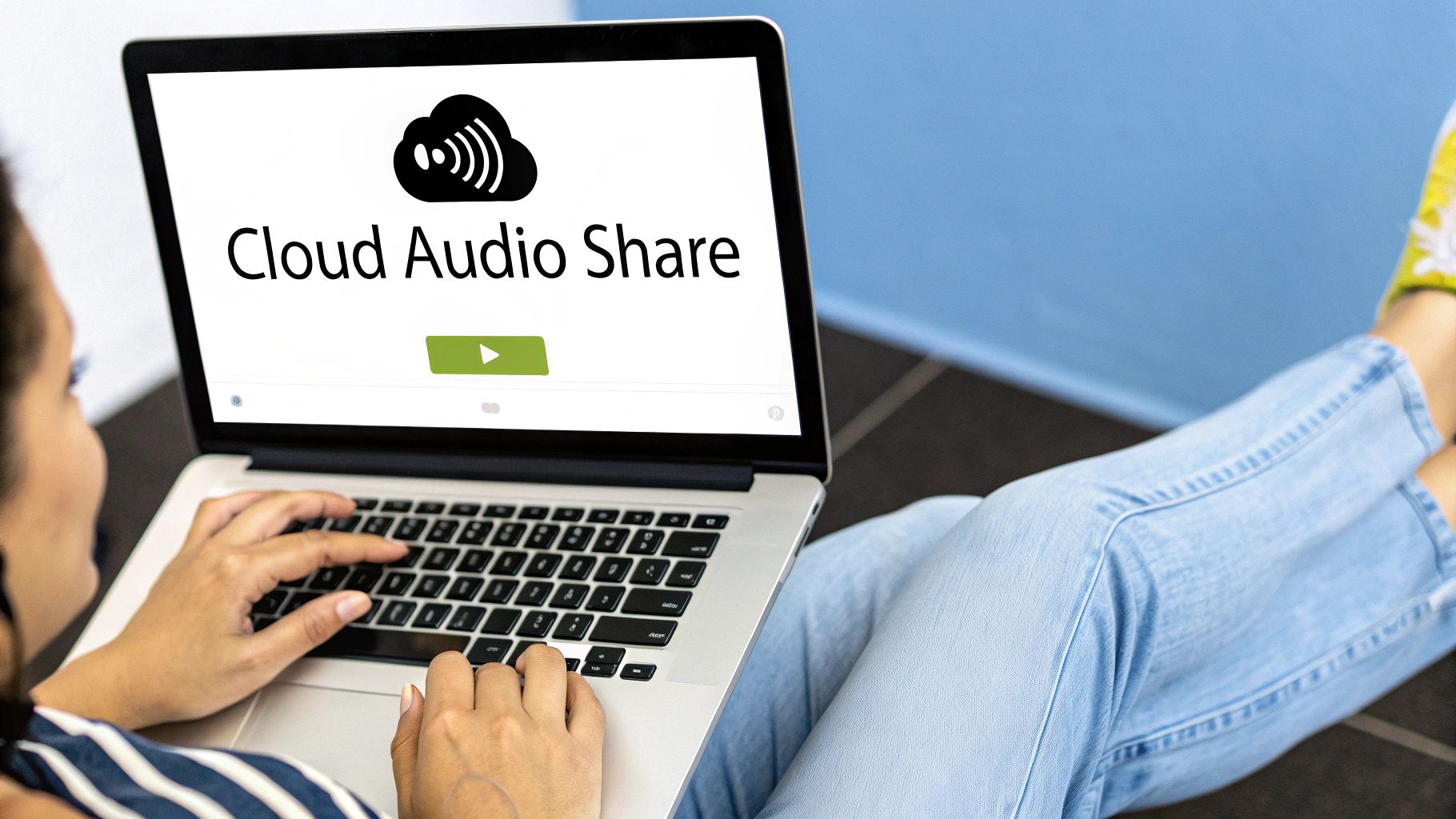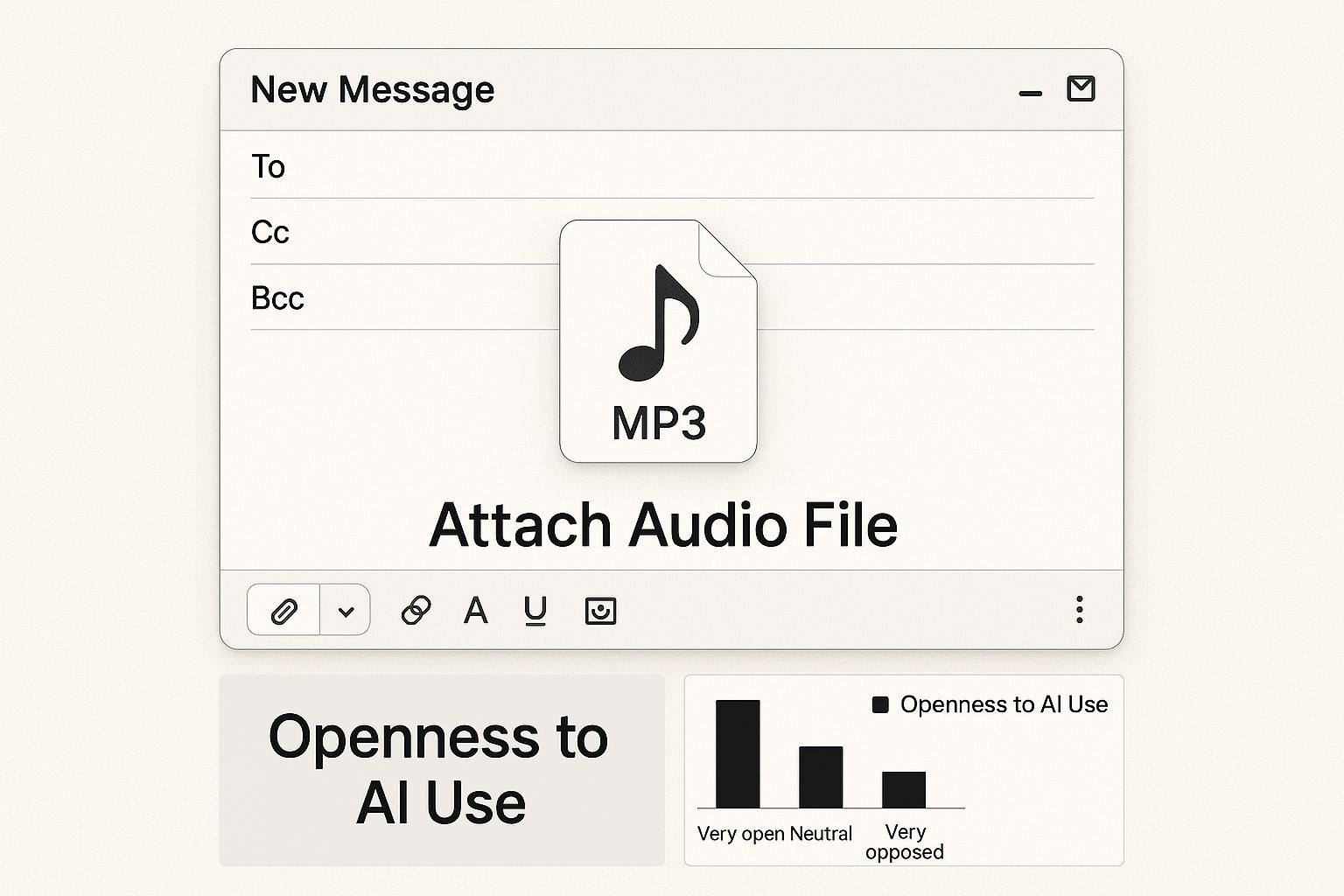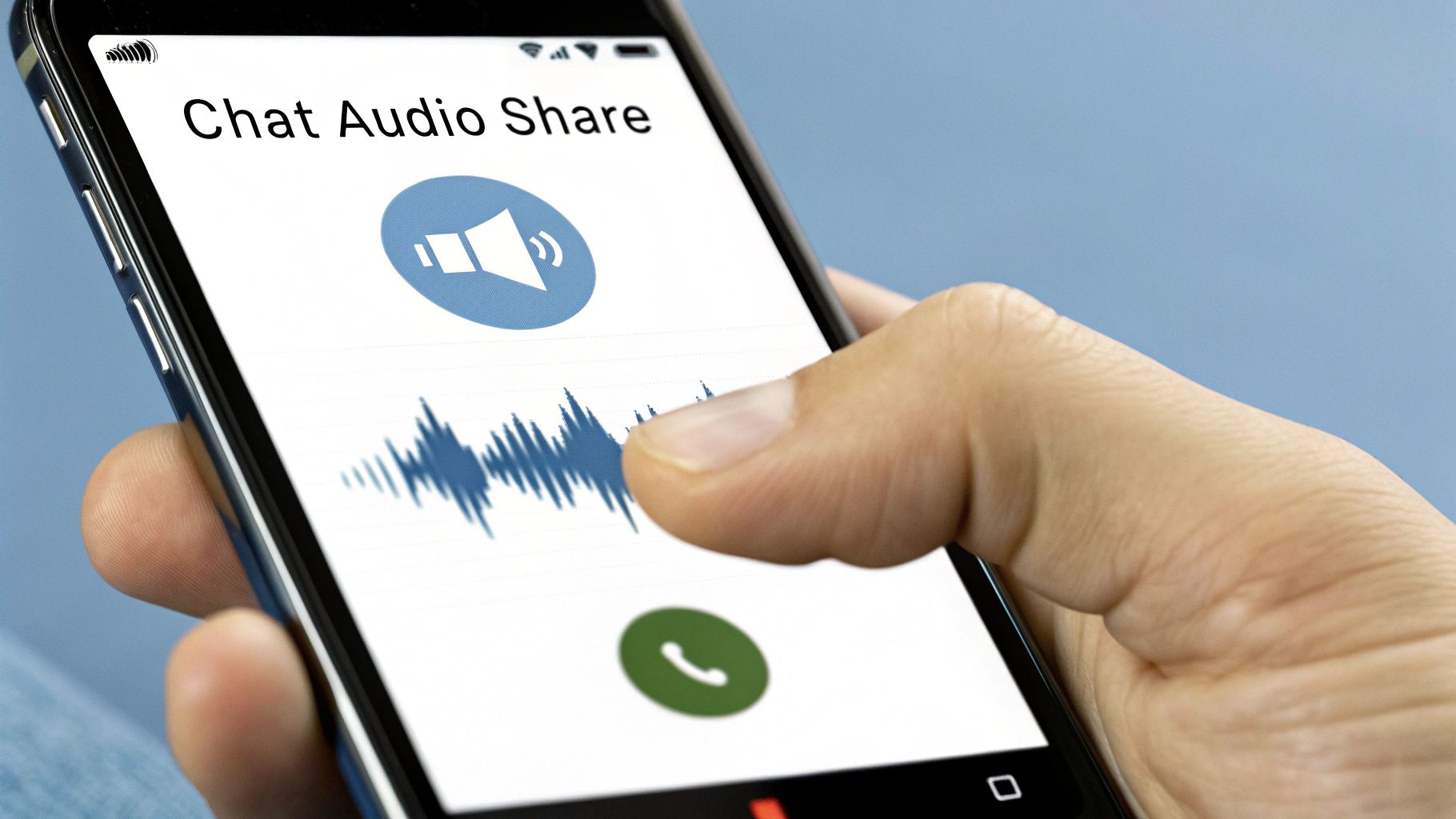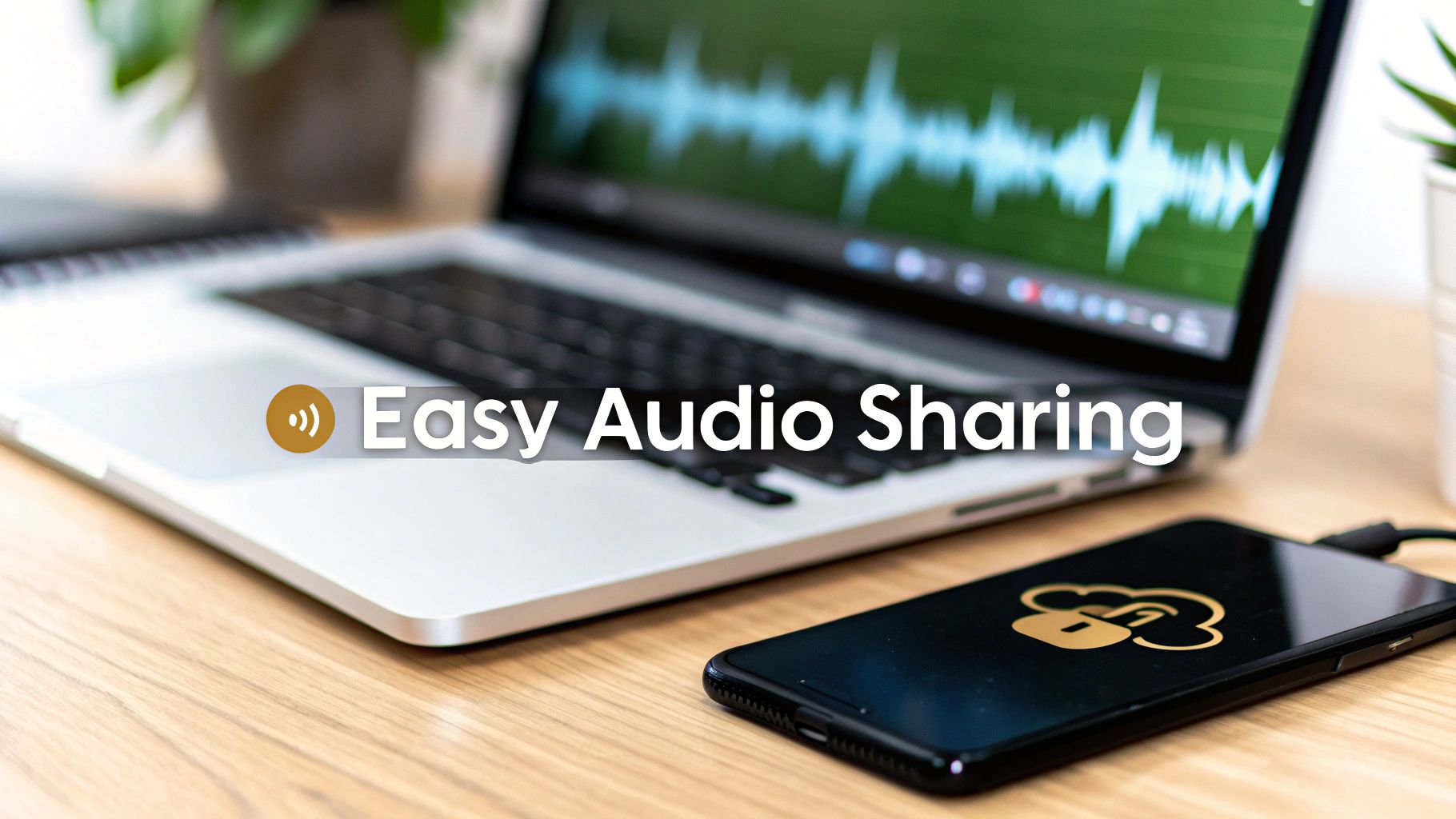Sharing audio files should be simple, right? For the tiny stuff, sure, an email attachment works. But when you’re dealing with the big guns—like your final master tracks or a full podcast episode—you need something more robust. For that, a dedicated service like HeftySend.com is a total game-changer. The right tool really just depends on the file's size and how pristine you need it to be on the other end.
Why Sharing Audio Files Is So Complicated
Ever tried to email a final song mix or a podcast episode, only to get slapped with that dreaded "file too large" error? It’s a classic, frustrating roadblock for anyone who works with sound. You've just spent hours getting the audio perfect, and now the last step—just getting it to someone else—is where everything grinds to a halt.
I wrote this guide because I know how painful sharing high-quality audio can be. We’ll get into the real-world problems you run into, from stingy email attachment limits to the painfully slow uploads on generic cloud storage. The goal is to get you past these hurdles so you can focus on creating, not file management.
The Everyday Hurdles for Creators
Sending audio just isn't as simple as sending a Word doc. The challenges often pile up, creating a bottleneck in your workflow that can stall projects and annoy your collaborators.
Here are a few of the headaches I see all the time:
- Absurd File Size Limits: Most email providers top out at a measly 25MB. That's nothing. A single uncompressed WAV file from a recording session can easily blow past 100MB, making email a total non-starter for professional work.
- Glacial Upload and Download Speeds: Let's be honest, general-purpose cloud services weren't built with massive media files in mind. Waiting forever for a multi-gigabyte session folder to upload, only for your client to complain about equally slow download times, is a massive waste of everyone's day.
- Sneaky Quality Degradation: Some platforms will "helpfully" compress your audio to save space, but they don't always tell you they're doing it. This compression can quietly suck the life out of your mix, stripping away the clarity and depth you worked so hard to create. The result? Your work sounds flat and amateurish.
- Clunky, Confusing Interfaces: Trying to navigate some file-sharing sites can feel like solving a puzzle. You’re often forced to create an account, dodge pop-up ads, or walk a non-technical client through a bizarre download process.
For anyone serious about their sound, finding a simple, secure, and reliable sharing method isn't just a nice-to-have—it's a critical part of a professional workflow. Your tools should make your life easier, not add another layer of complexity.
At the end of the day, these obstacles do more than just waste your time. They add friction to your creative process and can even make you look less professional to your clients. The good news? There are much, much better ways to handle this, and we're about to get into them.
The Easiest Way to Send Large Audio Files Instantly
When you're staring down a deadline with a massive, uncompressed WAV file on your hands, waiting hours for an upload just isn't an option. This is exactly where a dedicated transfer service becomes your secret weapon. For me, a tool like HeftySend completely changes the game. Forget the clunky cloud storage folders or the tiny attachment limits of email; this is about a direct, professional workflow that actually respects your time—and your audio's quality.

Let’s walk through a real-world scenario. I’m sure plenty of producers and sound engineers have been here before. You’ve just finished mastering a 2GB track for a client. It’s pristine, dynamic, and ready for that final sign-off. The last thing you want is for the delivery process itself to feel amateur or, worse, complicated for them.
This is why I love services built for this exact purpose. That’s why we built HeftySend—to solve this specific problem.
A Workflow That Actually Works
Instead of squashing your beautiful audio into a lossy format or splitting it into a zip file nightmare, a dedicated service keeps things simple. With HeftySend, you don't even need an account for a quick send. You just hit our site, drag and drop your file, and it’s on its way. It's built to be that effortless.
The whole process is incredibly straightforward:
- Upload Your File: Just drag your 2GB master track right onto the page. You’ll see the progress in real-time, no confusing menus or steps.
- Generate a Secure Link: Once the upload finishes, a unique, secure download link is created instantly.
- Share with Your Client: Copy that link and fire it off to your client via email, Slack, or whatever messaging app you’re using.
This direct approach cuts out all the usual friction. Your client doesn't need to sign up for anything, figure out a confusing folder structure, or send back that dreaded email: "Where do I click?" They just click the link, and the download starts. It’s that easy.
The goal here isn't just to move a file from point A to B. It’s about providing a seamless, professional experience that reflects the quality of your work. A simple, fast download process makes your client’s life easier and keeps the project moving forward without a hitch.
Adding a Professional Layer of Security
But what if the track is for a major release and needs to be kept under wraps? Sending an unreleased song through a generic service without any protection is a risk you just don't want to take.
This is where adding some security features becomes critical. With a tool like HeftySend, you can easily add password protection to your transfer. It’s a simple checkbox, but it means only the person with the password can access and download the file, giving both you and your client peace of mind. You can even set an expiration date for the link so the file isn't just floating around on the internet forever.
It’s a small step that adds a huge layer of professionalism and security.
This is why I'll always point people toward a dedicated file transfer service like ours. It's not just about the speed; it's about control, security, and making the entire handoff effortless for both you and your recipient. If you want to see this in action, you can learn more about how it works on our site and try sending a file yourself. The difference is immediately clear.
Comparing Your Audio Sharing Options
Look, while I'm a huge fan of dedicated services like HeftySend—especially when you're dealing with big or mission-critical files—it's only fair to see how it stacks up against the other methods you're probably already using.
Knowing the pros and cons of each is key. It helps you pick the right tool for the right job. So let's break down the most common ways people share audio so you can see where each one shines, and more importantly, where they fall short.
A Side-by-Side Look at Your Choices
To cut right to the chase, let's compare these options on the things that actually matter to anyone working with audio: file size limits, security, and just how easy they are to use. I’ve put together a quick table that highlights the key differences at a glance.
This really puts into perspective the frustration of trying to use email for anything bigger than a tiny soundbite.

As you can see, that familiar "attach file" button in your email is almost always the first to let you down when you're working with professional-grade audio.
To make things even clearer, let's organize the key details.
Audio File Sharing Method Comparison
Here's a side-by-side comparison of popular methods for sharing audio files, evaluated on the features that matter most for creators.
| Method | Best For | Max File Size | Security | Ease of Use |
|---|---|---|---|---|
| Email Attachments | Very short clips, quick voice notes | ~25 MB | Basic (Varies by provider) | Very Easy |
| Cloud Storage (Google Drive) | Collaborative projects, folder sharing | 15 GB (Free) | Good (With permissions) | Moderate |
| HeftySend | Large, high-quality files, client delivery | 20 GB+ | Excellent (Password/Expiry) | Very Easy |
This comparison really highlights the strengths and weaknesses of each approach, helping you decide which tool fits your specific needs.
Breaking Down the Trade-Offs
The table makes a few things immediately obvious. Email is super convenient for tiny files but completely impractical for any serious audio work. Its ~25 MB limit is a brick wall you'll hit instantly with any high-fidelity track.
Cloud services like Google Drive are a definite step up. They're great for teams that need to access and collaborate on the same folder of files. The downside? They can feel clunky for a simple one-off transfer, often forcing your recipient to have an account or navigate a messy folder structure just to find the download button.
This is where the value of a specialized service like ours becomes crystal clear. It's not just about a higher file size limit; it’s about a workflow designed specifically for sending, not storing. You get the simplicity of email with the power to handle massive files securely.
When you need to send a multi-gigabyte master track to a client, you want the process to be absolutely foolproof. A tool like HeftySend just removes all the friction—no account creation for the receiver, no confusing interface, just a direct link to the file.
It also adds professional security like password protection and expiring links, which is a must-have for unreleased music or sensitive client projects.
Ultimately, the best method really does depend on your specific situation. But for professional audio work where quality, speed, and a smooth client experience are non-negotiable, a dedicated transfer service is consistently the better choice. If you find yourself managing large files often, checking out the different HeftySend pricing tiers can show you just how affordable a truly professional workflow can be.
Choosing the Right Audio Format for Sharing
Does it really matter if you send an MP3 or a WAV file?
Absolutely. The audio format you choose is one of the most critical decisions you'll make, long before you even think about how you're going to send the file. It’s a direct trade-off between sound quality and file size, and that choice dictates everything that comes next.
Think of it like choosing between a raw, high-resolution photo from a professional camera and a compressed JPEG you’d post on Instagram. Both are useful, but you wouldn't use one for the other's job. The same logic applies here.

This is more important than ever, especially with how much audio we're all consuming. The global audio streaming market was already valued at USD 43.74 billion in 2024 and is expected to explode to USD 115.3 billion by 2030. That growth is fueled by our obsession with podcasts, music, and audiobooks on every device imaginable, making quality a huge deal.
Lossless Formats: The Uncompromised Choice
When you can't afford to lose a single drop of quality, lossless formats are your go-to. They are the gold standard—a perfect, bit-for-bit copy of the original recording, preserving every detail.
- WAV (Waveform Audio File Format): This is the king of uncompressed audio. It’s the standard in professional studios for recording and mastering. The files are massive, but they represent the purest, most authentic version of the sound.
- AIFF (Audio Interchange File Format): Think of this as Apple's version of WAV. It offers the same uncompressed, high-fidelity audio and is a staple in professional production circles, especially on Macs.
- FLAC (Free Lossless Audio Codec): Here’s where things get clever. FLAC is still lossless—meaning zero quality is sacrificed—but it uses smart compression to shrink file sizes by 30-50% compared to a WAV file. It’s the best of both worlds.
When do you need lossless? If you're sending a final master to a record label, a mix to a mastering engineer, or archiving a session for the future, always use a lossless format. Anything less is a compromise you don’t want to make.
Lossy Formats: The Practical Option
Lossy formats are all about convenience. They make life easier by using compression to dramatically shrink file sizes. The trick is that they intelligently remove bits of audio data that the human ear is least likely to notice.
- MP3 (MPEG-1 Audio Layer III): The one everyone knows. MP3s offer a fantastic balance of decent quality and tiny file sizes. This makes them perfect for streaming, sending quick previews to a client, or sharing reference tracks.
- AAC (Advanced Audio Coding): Often called the successor to the MP3, AAC generally delivers better sound quality at the same bitrate. It’s the format of choice for big players like Apple Music and YouTube for a reason.
Getting your format right from the start is a huge part of a clean workflow. If you want to dive deeper into making sure your audio is prepped and polished before you even think about exporting, understanding professional podcast editing workflows is a game-changer. It ensures that whether you choose lossless or lossy, your source audio is as pristine as it can possibly be.
Professional Habits for Sharing Audio Securely
Sending a file is just one part of the equation. Sending it professionally and securely? That’s what really sets you apart. A few simple habits can make a huge difference in your workflow, building trust with clients and protecting your valuable work.
These aren't complicated technical steps. They're the small, thoughtful details that show you care.
It all starts with something as basic as how you name your files. We’ve all been there, staring at a folder cluttered with names like final_mix_v3_final_final.wav. This isn't just messy—it creates genuine confusion for your recipient. A clean, consistent naming system is a professional courtesy that prevents mistakes and saves everyone a headache.
Build Trust Through Best Practices
Beyond just naming, a few key practices can streamline your entire sharing process and show clients you take their projects seriously. These habits are easy to implement and immediately signal a higher level of care.
- Zip It Up: If you’re sending multiple files—like stems, alternate mixes, or project documents—always package them into a single zip file. This is a huge courtesy. It saves your recipient from having to download a dozen individual files and ensures nothing gets misplaced.
- Embrace Password Protection: This is a non-negotiable for sensitive work. For unreleased tracks, client drafts, or any confidential audio, a password is your first line of defense. Services like HeftySend make this incredibly simple, letting you add one with a single click.
The goal is to make the experience on the other end as smooth and secure as possible. Every detail, from the file name to the delivery method, contributes to a professional impression and minimizes the risk of security mishaps.
The Non-Negotiable Step for Secure Sharing
With the sheer volume of audio being created and shared, security can't be an afterthought. By the end of 2024, streaming platforms hosted over 202 million distinct tracks, with roughly 99,000 new audio files being uploaded every single day. In this crowded space, protecting your unreleased work is paramount.
This is where a dedicated service really proves its worth. It gives you the tools to enforce security without adding complexity. HeftySend, for instance, not only allows for password protection but also gives you control over how your files are accessed—a crucial element for any professional workflow. You can learn more about the specifics in our privacy policy.
To keep things organized and secure, consider methods like recording and transcribing a Zoom conference to maintain accurate records safely.
Ultimately, these professional habits aren't just about good organization. They are fundamental to building trust and safeguarding your creative output.
Common Questions About Sharing Audio Files
Even once you get the hang of the basics, a few specific questions always seem to pop up. Think of this as your quick-reference guide for those nagging "what if" scenarios that trip people up. Let's dig into some of the most common questions I hear when people are figuring out how to share audio files.
Whats the Best Format for Audio Quality
If you want to preserve every single detail of your recording, lossless formats like WAV, AIFF, or FLAC are the only way to go. A WAV file is a perfect, uncompressed replica of the original audio, which is why it’s the studio standard for mastering and professional delivery.
FLAC is a fantastic alternative that I often recommend. It offers the exact same lossless quality but compresses the file size down by about 30-50%, making it a bit friendlier for transfers.
For quick previews, reference tracks, or just casual sharing, a high-bitrate MP3 or AAC is totally fine. But whatever you do, never send a lossy file for final mastering or any serious production work.
How Can I Send a Large Audio File from My Phone
This is a common headache, but it’s simpler to solve than you might think. Trying to email a huge WAV file from your phone is almost guaranteed to fail. The best approach is to use a dedicated file transfer service with a mobile-friendly website.
With a service like HeftySend, you can just open our site in your phone’s web browser, grab the file from your phone’s storage, and generate a shareable link on the spot. Then you can paste that link into a text, email, or whatever app you're using. It completely bypasses frustrating mobile carrier limits and your phone's built-in sharing restrictions.
The key is to avoid using apps that automatically crush your files. Sticking to a browser-based tool ensures your audio quality is preserved exactly as it is on your device, giving you a surprisingly professional workflow right from your phone.
Can I Just Send a Streaming Link Instead
Sure, sharing a private streaming link from a platform like SoundCloud can work for a quick listen or a preview, but it’s not the right tool for professional delivery. The audio is almost always compressed, and the person on the other end can’t download the original high-quality file to actually work with.
The growth in streaming is undeniable—in 2023, global on-demand audio streams hit a staggering 4.1 trillion. Still, when it comes to professional collaboration, a direct file transfer is always better. You can read more about these music streaming statistics on Toneisland.com.
And for those looking to polish things up before sharing, exploring some free AI tools for content creation can help you prep your audio more efficiently. But when it's time to deliver, giving your collaborators a direct download link to the original file is the most professional and reliable method, hands down.
Ready to stop worrying about file size limits and clunky sharing methods? With HeftySend, you can send up to 20 GB for free without even signing up. Just drag, drop, and get a secure link in seconds.
Give it a try and see how simple sharing large audio files can be at HeftySend.com.
